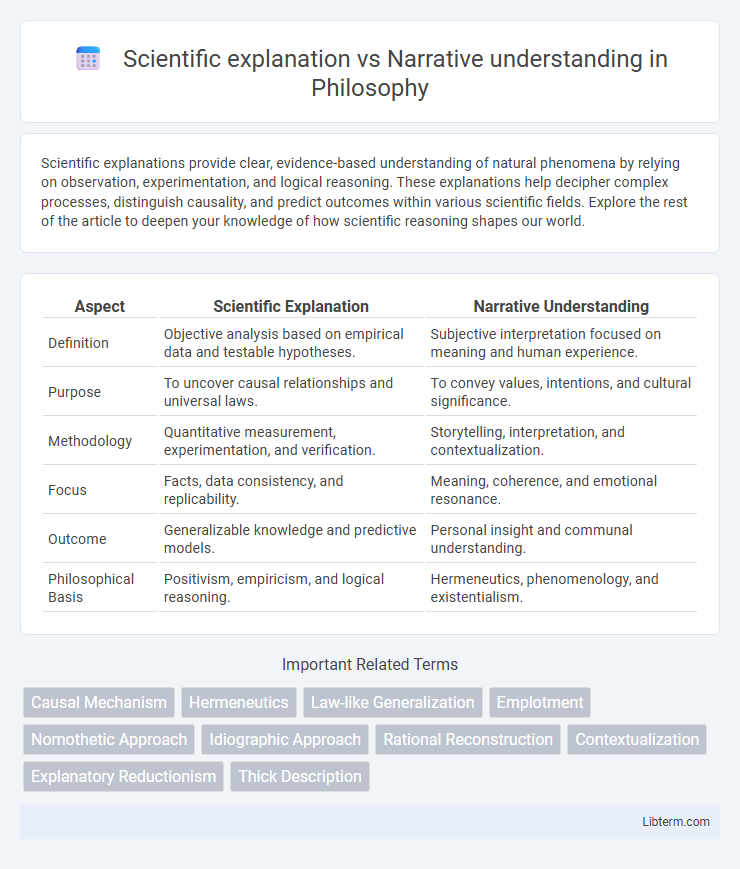Scientific explanations provide clear, evidence-based understanding of natural phenomena by relying on observation, experimentation, and logical reasoning. These explanations help decipher complex processes, distinguish causality, and predict outcomes within various scientific fields. Explore the rest of the article to deepen your knowledge of how scientific reasoning shapes our world.
Table of Comparison
| Aspect | Scientific Explanation | Narrative Understanding |
|---|---|---|
| Definition | Objective analysis based on empirical data and testable hypotheses. | Subjective interpretation focused on meaning and human experience. |
| Purpose | To uncover causal relationships and universal laws. | To convey values, intentions, and cultural significance. |
| Methodology | Quantitative measurement, experimentation, and verification. | Storytelling, interpretation, and contextualization. |
| Focus | Facts, data consistency, and replicability. | Meaning, coherence, and emotional resonance. |
| Outcome | Generalizable knowledge and predictive models. | Personal insight and communal understanding. |
| Philosophical Basis | Positivism, empiricism, and logical reasoning. | Hermeneutics, phenomenology, and existentialism. |
Defining Scientific Explanation
Scientific explanation involves systematically identifying causes and mechanisms through empirical evidence and testable hypotheses, emphasizing objectivity and reproducibility. It prioritizes quantifiable data and logical reasoning to establish generalizable laws that predict natural phenomena. This approach contrasts with narrative understanding, which centers on subjective meaning and contextual interpretation rather than causal analysis.
What is Narrative Understanding?
Narrative understanding involves comprehending events and experiences through stories that emphasize context, human emotions, and meaning rather than purely objective facts. It prioritizes personal perspectives and subjective interpretations, allowing individuals to make sense of complex social and psychological phenomena. This approach contrasts with scientific explanation, which relies on empirical evidence, causal relationships, and generalizable laws to explain occurrences.
Key Differences Between Scientific and Narrative Approaches
Scientific explanation relies on empirical evidence, testable hypotheses, and systematic observation to establish objective truths about phenomena. Narrative understanding emphasizes personal experiences, cultural contexts, and meaning-making processes, often capturing subjective and emotional dimensions. The scientific approach seeks generalizable laws, while narrative approaches prioritize individual perspectives and interpretive depth.
The Role of Causality in Scientific Explanation
Scientific explanation prioritizes causality by identifying cause-and-effect relationships that can be empirically tested and verified, providing objective and reproducible accounts of phenomena. Narrative understanding, in contrast, organizes events into coherent stories that emphasize human experiences, intentions, and contextual meanings rather than strict causal mechanisms. The role of causality in scientific explanation is central for establishing predictive power and validating theories, distinguishing it from narrative approaches that aim for interpretive insight.
Storytelling and Human Cognition
Scientific explanation relies on empirical evidence and objective analysis to uncover underlying mechanisms, whereas narrative understanding harnesses storytelling to construct meaning through personal and cultural contexts. Storytelling engages human cognition by activating memory, emotion, and imagination, facilitating comprehension and retention of complex information. This interplay highlights how narratives shape cognitive processes, making abstract scientific concepts more accessible and relatable.
Advantages of Scientific Explanation
Scientific explanation provides objective, evidence-based insights that enable accurate prediction and replication, enhancing reliability in understanding phenomena. It relies on empirical data and systematic methodologies, which minimize biases and subjective interpretation found in narrative understanding. This approach facilitates technological advancement and informed decision-making across diverse fields by establishing universal principles and causality.
Strengths of Narrative Understanding
Narrative understanding excels in providing context-rich explanations that connect events and human experiences, making complex information more relatable and memorable. It facilitates emotional engagement and meaning-making, which enhances comprehension and retention beyond purely factual or scientific data. This approach supports holistic insight by integrating cultural, psychological, and social dimensions often overlooked by scientific explanations.
When Science Meets Narrative
Scientific explanation relies on empirical evidence and testable hypotheses to describe natural phenomena, offering objective and reproducible insights. Narrative understanding, by contrast, emphasizes human experiences and cultural contexts, providing meaning through storytelling and subjective interpretation. When science meets narrative, integrating data-driven facts with human-centered stories enhances communication, making complex concepts relatable and fostering deeper engagement in scientific discourse.
Integrating Both Modes for Deeper Comprehension
Integrating scientific explanation with narrative understanding enhances deeper comprehension by combining empirical evidence and human experience. Scientific methods provide objective data and causal mechanisms, while narrative approaches offer contextual meaning and emotional insight. This synthesis fosters a holistic grasp of complex phenomena, bridging quantitative analysis with qualitative richness.
Implications for Education and Communication
Scientific explanation emphasizes objective evidence and systematic testing, promoting critical thinking and analytical skills essential for education. Narrative understanding facilitates meaning-making and emotional engagement, enhancing retention and motivation among diverse learners. Integrating both approaches in education and communication fosters comprehensive comprehension and effective knowledge transfer across varied audiences.
Scientific explanation Infographic

 libterm.com
libterm.com